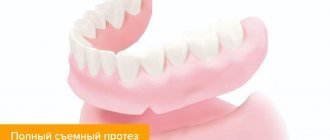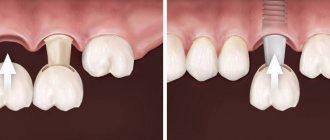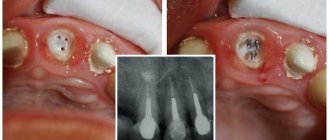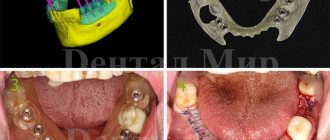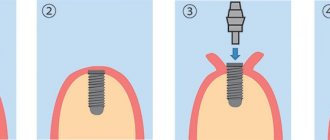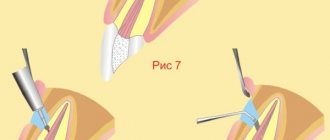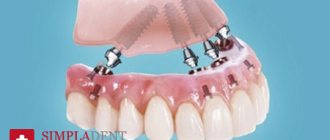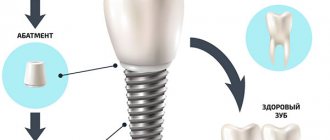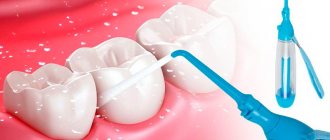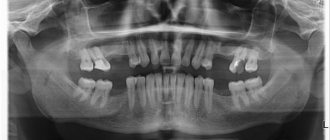A surgical guide is often used to install implants. It is not needed in all cases of implantation, but sometimes it is simply necessary. What it is, how it is made and what it is needed for, we will tell you in this article.
Dental implantation and dental prosthetics on implants are becoming increasingly the preferred method of restoring lost teeth every year. The installation of implants is growing annually in both quantitative and qualitative terms. This method of prosthetics is extremely practical, functional and has very high aesthetic values.
One of the most important factors in the success of a dental implant procedure is the accuracy of implant placement. Today, various computer programs make it possible, using 3D modeling technology, to achieve the most accurate immersion of the titanium root into the bone, with the correct determination of the depth and angle of inclination.
Surgical template - what is it?
It is a mouthguard, which is essentially a stencil-overlay. Depending on the clinical picture, it is fixed in the oral cavity on the bone, on the mucous membrane or on preserved teeth. The template contains guide holes through which the specialist actually directs the implant to a precisely specified location, to the required depth and angle of location.
Using a surgical template, the implantologist installs implants with high precision, eliminating errors that may be caused by human factors.
Indications and contraindications
Factors that determine the relevance of using a surgical template include:
- The absence of several sequentially located units, making it difficult to determine areas for installation of implants;
- Adentia in the frontal area of the dentition, the elimination of which is associated with high demands on the aesthetics of dentures, including their position in the smile zone;
- The need to form tunnel canals at an angle to the surface of the jaw, caused by the presence of abnormal developmental defects;
- Design of prostheses used for temporary replacement;
- The need to organize flapless surgery.
The technique, due to its harmlessness to the patient’s body, has no restrictions. The only limiting factor is the lack of feasibility of installing implants - if there are appropriate medical contraindications, it is recommended to use alternative methods of prosthetics.
Situations for using a surgical template.
- Implantation and prosthetics using the All-on-4 (all-on-6) method.
- There are cases when the installation of implants is possible when there is insufficient bone tissue without its preliminary restoration. The template makes it possible to place the implant in a place where there is enough bone to surround the implant.
- If the jaw is missing 3 or more teeth in a row.
- If teeth are completely missing and a large number of implants are required.
- Installation of implants in the frontal (front) segment of the jaw, where there are very high requirements for the aesthetic component.
- In the case of conditionally removable or fixed prosthetics using beam fastenings.
Making a surgical template is always an individual process for each patient. It is done in specialized dental laboratories, which are equipped with the necessary modern equipment.
Advantages of using an implant template
Maximum precision placement
If previously all calculations for installing an implant were carried out manually and were not particularly accurate, then with a surgical template you can calculate the placement of the implant, the degree of inclination and the drilling depth with an accuracy of 0.1 mm or 1 degree. This helps eliminate the situation when it is impossible to screw on the crown during implant prosthetics. Or the design causes an overload of the implant, which can cause the bone to sink faster, or the dental implant simply breaks.
Longer service life
Due to the correct placement of a tooth implant in the bone, its service life can be increased.
Ideal for all-on-4 prosthetics
The All-on-4 Surgical Guide is a great solution. Thanks to it, precise installation of implants is achieved, which with this method must be placed at an angle or in anatomically dangerous places (near the maxillary sinus). It is very difficult to calculate this by eye, but it is easy to make a mistake by a millimeter to the left or a millimeter to the right.
No deep cuts
Swelling, severe pain and a long healing process are the eternal companions of manual dental implantation. Navigation surgery helps avoid this for those patients who have enough bone and do not need to build anything up. Then the operation becomes a minimally invasive procedure. Fewer incisions mean less pain and faster healing.
Using surgical templates, you can perform resection of the root apex, avoiding large incisions.
Save time
The implant installation time is reduced from one hour to 20 minutes.
Predictable outcome of the operation
With guided surgery, the predictability of the outcome of the operation increases significantly. In some cases, the procedure for installing an implant becomes even easier than removing a tooth.
Even for those patients who have little bone tissue, it will be possible to organize proper prosthetics and, accordingly, use a digital template to plan how and where to add bones in order to avoid loosening or rejection of the implant.
What are the positive aspects of using a template for a patient:
- The invasiveness of the operation is significantly reduced; the implantologist does not need to make incisions; he pierces the gum in the place marked in the template. After such an intervention, healing occurs much faster and more painlessly. The likelihood of postoperative swelling is reduced.
- The operation time is reduced, since the doctor does not need to mark places for installing implants. All this has already been done on the template with high accuracy.
- The prognosis for implantation success is much higher due to the fact that the position of the implants is determined with the most accurate calculation down to the millimeter. The risks of installing implants in the wrong position due to human factors are eliminated.
- It is possible to install a temporary orthopedic structure on the day of surgery.
Pros and cons of surgical guides
- A more favorable prognosis for the operation: the human factor is minimized, accuracy is maximized.
- The operation takes less time: the positions where the implants need to be installed have already been calculated and designated.
- The invasiveness of the operation is reduced: when using a template, the surgeon does not cut the gum, but immediately pierces it in the place indicated on the template.
- Consequently, healing occurs faster. The risk of inflammation and swelling after implantation is minimized.
- Making a template for implantation takes some time; This can be unnerving for those who want to quickly get over medical procedures and forget about them. Usually the template is made in two to three days.
- If it is decided that a patient needs guided implants, the price they will have to pay for new teeth may increase. True, this does not always happen: for example, when the use of a template allows one to avoid bone tissue augmentation, this, on the contrary, reduces the cost of prosthetists’ services.
There are only two disadvantages of using a template for a patient:
- It takes extra time to make it.
- Additional financial payment for template production. But making a template does not always lead to an increase in the cost of implantation. In the case when it is used when there is a lack of bone tissue, given the absence of payment for bone grafting of teeth, implantation becomes cheaper using a template.
Considering the listed advantages and awareness of the complexity of the procedure, focusing on a high-quality long-term result, it is unlikely that these disadvantages can play a decisive role in order to save time and money.
Procedure for making a surgical guide.
The production of the template, as well as the implantation procedure, in the Es-Dent center, starting from the initial consultation, is planned by two specialists in the complex: an orthopedic dentist and a dental implant surgeon.
First stage.
Diagnostics. The patient is given a 3D image on a CT scanner. After careful analysis and planning of implantation: choosing the type of implants, determining their location, choosing an orthopedic design, the orthopedic dentist takes impressions (casts) from the patient’s jaws.
Second phase.
3D modeling. The casts are scanned, taking into account the diagnostic data, and a 3D model is created. A specialized computer program models and calculates the exact location of the planned implants, and a model of the orthopedic structure is also created.
Third stage.
Manufacturing. Based on the created model, the production of a surgical template begins, which will contain guide holes for implants and special fasteners for fixation on the patient’s jaw. The template is made in laboratory methods or on modern equipment using CAD\CAM computer technology.
For more information and to make an appointment with a specialist, call:
+7,
Advantages and disadvantages
Positive aspects of using surgical guides include:
- Accuracy of determining areas of implant integration during prosthetics;
- Reducing the likelihood of base rejection;
- Reducing the time spent on the operation;
- Minimizing damage to tissue structure;
- Reducing the rehabilitation period;
- Possibility of predicting the results of surgery.
Among the disadvantages of the technique, it is worth noting only the additional costs associated with the production of an anatomically accurate template. However, the successful practice of dental prosthetics, carried out using surgical patterns, determines the growth of their popularity.
Manufacturing materials
A variety of materials are used to create surgical guides. The most popular are acrylic and medical polymers, characterized by their colorless texture, flexibility and tight fit. The proliferation of digital equipment is contributing to the growing demand for templates made using CAD/CAM technology, ensuring accurate planning, and being resistant to thermal influences.
Types of templates
The basis for the classification of templates used in dental orthopedics is their design features. The existing differentiation provides for the following division:
- Surgical templates fixed to bone tissue - models equipped with mini-implants, in demand for partially and completely edentulous dentition;
- Templates placed on preserved units - provide for the presence of fixing elements placed on the surface of healthy teeth and are recommended when planning operations with the separation of tissue flaps;
- Frame systems adjacent to the gum tissue, suitable for complete edentia, and also used for non-invasive surgical operations.
In addition, the existing differentiation allows the use of alternative criteria, including those based on the types of devices used to form channels for implants.
In what cases is a navigation template used?
It is advisable to use a surgical template for implantation in the following situations:
- The need to restore teeth in the frontal part of the jaw;
- If there is a shortage of more than a few units in a row;
- The need to implement a minimally invasive treatment method;
- If any pathologies are detected in the structure of the jaw system, which causes the need for drilling at an angle;
- If the installation of a temporary orthopedic structure is carried out immediately after fixation of a dental implant (one-stage dental implantation);
- Fixation of an orthopedic structure of a removable or conditionally removable type;
- In the presence of atrophic processes in bone tissue, provoking the need to place implants in areas directed towards other bones.
Features and benefits of the procedure
Unlike the conventional technique, implantation using a surgical template is an atraumatic and most precise procedure, in which no incisions are made and no gingival flap is removed, which also does not require postoperative sutures.
Implantation using a template (step by step):
- Preparing the patient: examination and sanitation of the oral cavity, studying the medical history, etc.
- Taking impressions.
- Carrying out computed tomography.
- Making a Surgical Template
. - The patient is given local anesthesia (sedation if necessary).
- Fixing the finished template onto the patient’s jaw.
- The most accurate puncture of the gums along the guides of the template.
- An artificial root is implanted into the formed hole.
- At the final stage, a crown is installed on the implant.
This procedure greatly simplifies the doctor’s work and eliminates the possibility of complications during and after implantation.
Other advantages of implantation using a template:
- the risks of medical error when implanting an implant are eliminated;
- reduction of surgical intervention time;
- minimally invasive procedure with minimal tissue trauma;
- the puncture is done with maximum precision;
- accelerated tissue healing process during the rehabilitation period;
- less pronounced swelling of the gums;
- immediately after implantation of the artificial root, the dental crown can be secured;
- the risks of implant rejection and postoperative complications are almost zero.
Template for dental implantation
allows you to simultaneously implant several implants in one procedure.
The disadvantages of the technique include an increase in the total duration of prosthetics by 2-3 days, spent on the process of manufacturing a surgical template.
Indications
Navigated installation of dental implants is indicated if:
- there are 3 or more units missing in one row;
- implants are implanted in the frontal zone;
- Clinical anomalies of the jaw structure have been identified, in which it is necessary to prepare the bed at a large angle;
- bone atrophy has been diagnosed - implants must be directed to areas of the jaw with suitable sizes and density;
- a minimally invasive operation is to be performed (without peeling off the gum flap);
- A non-removable, conditionally removable beam structure is fixed onto the implants.
If you need to restore 1-2 teeth in the chewing area, the use of 3D technology is not justified. It is not possible to use templates for anomalies of the maxillofacial apparatus, for macroglossia, when the patient cannot open his mouth wide - it will not be possible to fix the structure in the mouth.
Create a template
The process of developing a template is not fast, it requires precise mathematical calculations, so a team of dental surgeons, an orthopedist and a dental technician is working on the creation. Analytical work consists of several stages:
- A 3D image of the patient is converted into a DICOM (Digital Imaging and Communications in Medicine) medical file and loaded into a special program - this is a bone landmark when creating a template.
- In parallel with this, a guideline is created based on the position of the soft tissues: a scan of the teeth (taken at the appointment, or a scan of the plaster model is pre-scanned) is uploaded into the program. The result is a true scan, where a computer program is used to design the ideal location for the implants in the correct prosthetic position, their size, inclination and shape of the prosthesis.
- After virtual planning, the dental technician sends the finished digital template to 3D printing, resulting in the doctor receiving a mathematically accurate surgical template for the upcoming work on the patient.
- After printing, a metal sleeve (a guide for installing an implant or orthodontic miniscrew) is installed in each hole of the template.
How much does dental implantation with a surgical guide cost?
In modern dental centers, a surgical template is used for dental implantation . Price
depends on the complexity of the design, the method of implantation, the number of guides and the material used.
Dental implants can be installed using surgical templates. The procedure is carried out by highly qualified specialists using advanced techniques, high-quality material and modern diagnostic and treatment equipment. A customized surgical template is produced. Price
depends on the number of implanted units and other nuances. The website has a price list for all dental services.
We also offer to take advantage of our promotional offers and receive a 3% discount on dental implantation using a template by leaving your reviews on the Aesthetics dentistry website (the discount is additional and is added to the main ones). You can make an appointment for a consultation with an implant dentist by phone.
Implantation without surgery using a surgical template - Advantages:
- the operation is comfortable and painless – a puncture is actually made, not an incision in the gum;
- installation of implants takes less time;
- swelling of the gums is less pronounced;
- accelerated healing process;
- implantation becomes completely planned: the position of the implant is determined in advance, taking into account all the characteristics of the patient.
The method of implantation without surgery is unique in that it reduces the list of contraindications. It is suitable for installing implants even in patients with diabetes mellitus and endocrine diseases (in remission).
However, there are contraindications - this is an insufficient volume of hard tissue (bone) in the implantation area.
Price of a surgical template at the Implantmaster clinic
If you are interested in a surgical guide for implantation, the price of this device may vary based on the technique used, the material involved and the number of guides. For example, an acrylic surgical template for implantation can cost more than 6,000 rubles in Moscow, provided that at least three dental units are fixed. In turn, a template obtained in three-dimensional format using innovative technologies will cost you at least 30,000 rubles.
This amount is added to the cost of dental implantation.
